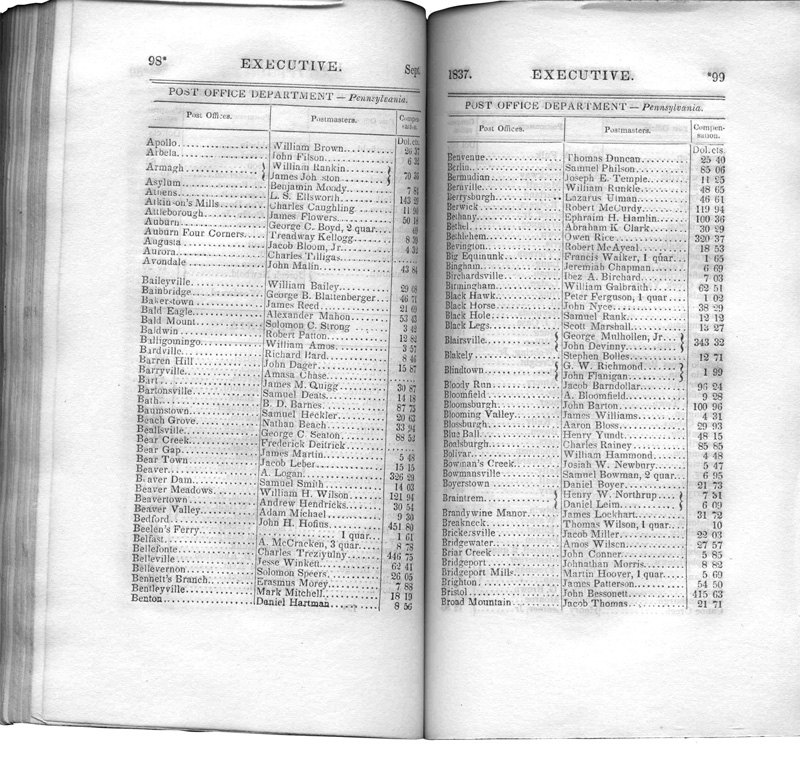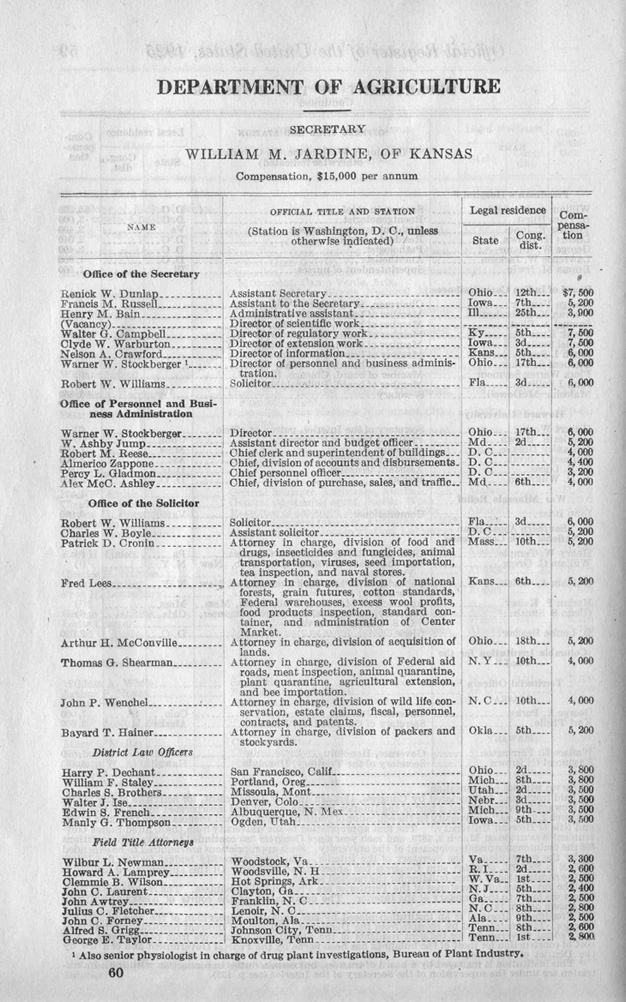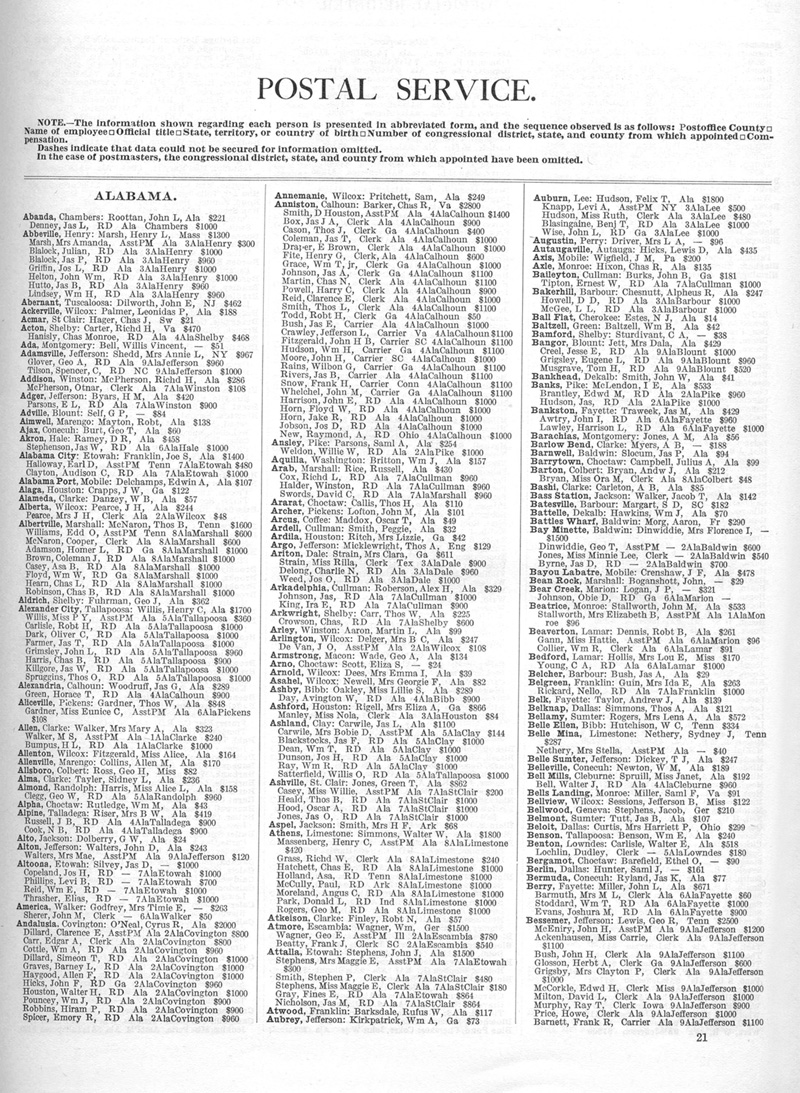
The Official Register of the United States, 1816-1959
Winter 2004, Vol. 36, No. 4 | Genealogy Notes
By John P. Deeben
In 1836, a young man named Jacob Bloom was appointed postmaster for the small rural township of Augusta, Pennsylvania. He received an annual income of $4.32. Bloom's tenure ended eight years later when the Augusta post office temporarily closed. His final salary in 1843 was $9.95. Employment information such as Jacob Bloom's is typical of what you can find in the Official Register of the United States. As a national directory of employees, agents, and officers of the federal government from 1816 to 1959, the Official Register provides a valuable reference tool and quite often an essential starting point for genealogy research.
The Scope of the Official Register
On April 27, 1816, Congress authorized publication of the Official Register of the United States. Produced every two years in conjunction with the sitting of each new Congress, the Official Register (initially referred to as the Biennial Register or the Blue Book) contained comprehensive listings of all civilian, military, and naval employees, officers, and agents of the federal government. The lists were arranged by department and thereunder by agency, bureau, or office. Congress also required the secretary of the navy to provide the names, force, and condition of all ships and vessels belonging to the United States, including when and where they were built. The legislation approved five hundred copies of the Register to be printed by the last day of September during each publication year. Copies of the Register were supplied to members of Congress, the President, the Vice President, and the head of each executive department. Ten extra copies went to the secretary of the senate and the clerk of the house of representatives, and another twenty-five copies to the Library of Congress. The remaining volumes were left for Congress to distribute as it saw fit.
The first issue of the Official Register was modest in size, containing 176 pages with 6,327 names. Subsequent acts of Congress, however, expanded the scope of the Register's content. An act of July 14, 1832, directed the Official Register to include the names of all government printers, a statement of monetary allowances to mail contractors from the postmaster general, as well as correct lists of all presidents, cashiers, and directors of the Bank of the United States and its branches. Other departments, agencies, and bureaus were added to the Register as they were created.
A few later congressional statutes added special stipulations to the Official Register. On March 3, 1893, Congress required the Register to include a statement of the number of officers and employees by department in the executive branch, the Government Printing Office, and the offices of the government of the District of Columbia, as well as the aggregate amount of their salaries and other compensation. A 1902 statute specifically added employees of the comptroller of the currency, including bank examiners, receivers, attorneys for receivers, and clerks.
Organization of the Official Register
From 1817 to 1905 the Official Register was arranged in a tabular format. The chief advantage to this layout was that it provided an overall picture of the organizational structure of each department, as well as a sense of the "magnitude and importance" of each office with respect to the number of employees. The tables contained such information as the employee's name, job title, state or country of birth, location of post, and annual salary. The military lists provided the names of officers, rank, and place of birth, while the naval lists also included date of commission and current duty station. An act of Congress on March 3, 1851, ordered the insertion of an additional column to the Register to show the state or territory from which each employee was appointed. The early volumes of the Official Register from 1817 to 1875 did not contain an index but had a table of contents arranged alphabetically by department, office, or position. From 1877 to 1905, an alphabetical name index appeared at the end of each volume.
In 1907 the Official Register's format underwent a major change. Director of the Census S.N. Dexter North determined that the Official Register had become too large and costly. Over the years the Register had grown in size by approximately 50 percent each decade. The 1905 edition alone contained 4,219 pages with 349,075 names and cost $70,800 to produce. North estimated the 1907 edition would include almost 4,588 pages and cost $78,000.Facing such mounting problems of volume and expense, North determined that the old tabular format was no longer practical. Instead, he recommended that the Official Register be changed to a directory format consisting of one-line entries for all federal employees arranged alphabetically by surname. The entries still contained all the pertinent information required by law but employed an extensive system of abbreviations to achieve a noticeable economy of space. Additional tabular entries identified the principal officials of each department, providing in more compact form an overall statement of departmental organization. The Printing Commission of Congress approved the changes, and the 1907 edition of the Official Register was published at a modest cost of $25,600 and contained a mere 1,504 pages. The switch to the directory format also eliminated the need for a comprehensive name index. The Official Register continued to use this design until the early 1920s.
The economy achieved by the director of the census caused further changes to the Official Register in subsequent years. As the federal government continued to expand, attempts to streamline information in the Official Register led to the gradual elimination of most nonadministrative federal employees. Along with the format change in 1907, the names of temporary employees with service of less than six months were immediately eliminated from the Register, along with all substitute mail carriers. On October 22, 1913, Congress passed the Urgent Deficiency Act, which authorized the elimination of many nonessential government publications. As part of that legislation, all information relating to the Postal Service, including the statement of allowances to mail contractors, was removed from the Official Register. The list of ships and vessels belonging to the United States was eliminated as well.
In 1917 all U.S. Army, Navy, and Marine Corps officers, cadets, and midshipmen were omitted from the Official Register because the information was already available to the public in annual registers published by the War and Navy Departments. Only military officers detailed for administrative service in the District of Columbia were listed by name and official designation. Various classes of employees not holding regular or full-time status were also eliminated. After 1921 the Official Register removed the all-name directory completely, reverting to lists in table format of administrators and supervisors in each executive and judicial department of the federal government and the District of Columbia, whose salaries were paid directly by the U.S. Treasury. Officials believed the format change once again would provide all the requisite information of general interest concerning government personnel. At this time the Register became a yearly publication as well. It remained in this format until the final volume was produced in 1959.
The Postal Service
The natural growth of the federal government, as noted above, affected the size of the Official Register over the years. The most noticeable departmental growth occurred within the U.S. Post Office and the Postal Service. By 1879 the Post Office Department lists included not only employees of the Office of the Postmaster General and the first, second, and third assistant postmaster generals, but also the superintendent of the money-order system, the superintendent of foreign mails, the Office of Assistant Attorney General, post office inspectors, the Stamped-Envelope Agency, the Postal-Card Agency, and the Postage-Stamp Agency.
The size of the Postal Service proved even more distinctive because its vast network of post offices, services, and bureaus spanned the entire country. These included the Railway Mail Service, the Special Mail Service, the Mail Messenger Service, and the Free-Delivery System (comprising letter carriers.) The burgeoning lists of mail contractors completed the expansive nature of the Postal Service. (By 1911 mail contractors included almost every conceivable type of transportation service, including railway, electric and cable car, steamboat, stage, and wagon. The Postal Service also contracted foreign mail transfer services and pneumatic tube services.)
By 1879 the increasing size of the Postal Service finally created printing problems for the Official Register that required immediate attention. Officials responsible for compiling the Postal statistics realized that the mandated deadlines could no longer be met. It was therefore decided to divide the Official Register into two volumes and publish the employees of the Postal Service separately. By doing so, the remaining employee statistics of the federal government would still be available to Congress by the prescribed deadline. Publication of the Postal Service volume would follow as soon as practical. Officials believed that such an arrangement would best serve public convenience.
The Official Register continued as a two-volume publication from 1879 to 1911. Each volume included a separate surname index until the directory format was introduced in 1907. By 1911, however, the director of the census determined that the Postal Service volume had become too difficult and costly to produce. The 1911 volume alone had comprised 774 pages and cost $12,600 to print. The complex task of preparing the volume further diminished its usefulness, because the required statistics could only be obtained by corresponding directly with all 59,237 post offices across the country. The compilation of data thus became a very time-consuming process, often taking as long as six months. As a result, much of the data became obsolete by the time it was published. (The Census Bureau often detailed clerks to other offices where staffing was insufficient to prepare the required information within a reasonable amount of time, but only in 1909 did they succeed in publishing the Postal Service volume within the mandated deadline.) In many cases, the accuracy of the returns proved very doubtful as well.
For all practical purposes, the value of producing the Postal Service volume diminished considerably. As part of the 1913 Urgent Deficiency Act, therefore, the names of all Postal Service employees were removed from the Official Register, reducing it once again to a single volume publication. The director of the census subsequently declared that the omission of the information appeared satisfactory to the public because no complaints had been received and few inquiries made regarding the absent data.
Related Records
The Official Register of the United States offers a convenient starting point for genealogy research on civilian employees of the federal government. In the various listings of the Register, researchers can discover at a glance whether or not an ancestor worked for the government in a given year and also identify the department, bureau, or office they served. In many cases, the breakdown of department listings into specific jobs provides additional detail on the nature of work performed. In 1867, for example, the Office of Public Buildings, Grounds, and Works in the War Department listed personnel who worked in such obscure positions as lamplighters, draw-keepers at the Potomac and Eastern Branch bridges, and furnace keepers in the White House. Genealogists can also readily identify the place of birth for most employees, and the congressional district from which they were appointed. The lists of annual salaries and contractor allowances provide a general picture of the economic conditions under which federal employees served. In effect, the Official Register offers an initial snapshot of life as a federal employee from 1816 to 1959.
From the general information provided in the Official Register, researchers may consult other records for further detail. Appointment records of the various executive departments, for example, often provide additional information regarding federal employees. Postmaster Jacob Bloom offers an excellent illustration. The Official Register first listed Bloom at the Augusta, Pennsylvania, post office in the 1837 edition. A quick search of the register of appointments for the Post Office Department (Record Group 28) reveals that Bloom actually was appointed postmaster on September 17, 1836. The post office closed on January 4, 1844, and Bloom's service ended. When the office reopened two years later on February 19, 1846, a new postmaster was named.
To uncover further information about employees of other government departments, consult National Archives finding aids to determine how those agencies' appointment files are organized. Some appointment records, such as those for Jacob Bloom, are also available on microfilm (M841, Record of Appointment of Postmasters, 1832–September 30, 1971.)
The National Personnel Records Center (NPRC) in St. Louis, Missouri, offers another source for information on federal employees after 1907. The NPRC is particularly useful for information regarding employees who were subsequently eliminated from the listings of the Official Register, such as the Postal Service workers after 1911. Keep in mind, however, that records less than seventy-five years old remain closed to public examination. Of the files that are available, most provide adequate genealogy information, such as full name of the employee, position held, agency, and place and term of service. Records may also include place of birth, age, state from which appointed, and salary. The amount of material in the files often varies, but some may also include letters of application and recommendation containing a wealth of biographical information.
Published government documents provide a rich source of information regarding people who worked for the federal government. The Official Register of the United States clearly stands out as one of the best examples of such publications. Researchers may usually access the Official Register at many large universities and public libraries. Most U.S. Government Depository Libraries, as well as the Archives Library Information Center (ALIC) at the National Archives, also contain sets of the Register. (The National Archives' set, however, is currently incomplete; the early volumes from 1817 to 1829 are missing.) Other federal depository libraries may be located online at GPO Access. Select portions of the Official Register are posted on the Internet as well. Links to the Navy and War Department lists for the Civil War period, for example, are located on the America Hurrah! web site. Some volumes of the Register (1883–1893) were also published in the U.S. Congressional Serial Set. Regardless of the type of media or format, the Official Register of the United States offers an easily searchable tool for genealogical research.
John P. Deeben is an archives technician in the Research Support Branch of the National Archives and Records Administration, Washington, D.C. He earned B.A. and M.A. degrees in history from Gettysburg College and Penn State University.
Note on Sources
Principal analyses of the Official Register, including general background information and related legislative history, were derived directly from preface and appendix material in The Official Register of the United States (Washington: Government Printing Office, 1879–1959). Earlier volumes of the Register cited were published by various private contractors under the title The Biennial Register of Officers and Agents in the Service of the United States.
Additional background information on the Official Register, including general descriptions of related records at the National Personnel Records Center (NPRC), was found in Anne Bruner Eales and Robert M. Kvasnicka, eds., Guide to Genealogical Research in the National Archives of the United States, 3rd ed. (Washington: National Archives and Records Administration, 2000.)
The example of related appointment records concerning Postmaster Jacob Bloom were part of a subseries entitled Records Relating to Appointments of Postmasters, 1815–1971, within the series Records of the Division of Postmasters in the Records of the Post Office Department (Record Group 28). These records have also been microfilmed as National Archives Microfilm Publication M841, Record of Appointment of Postmasters, 1832–September 30, 1971, 145 rolls.


